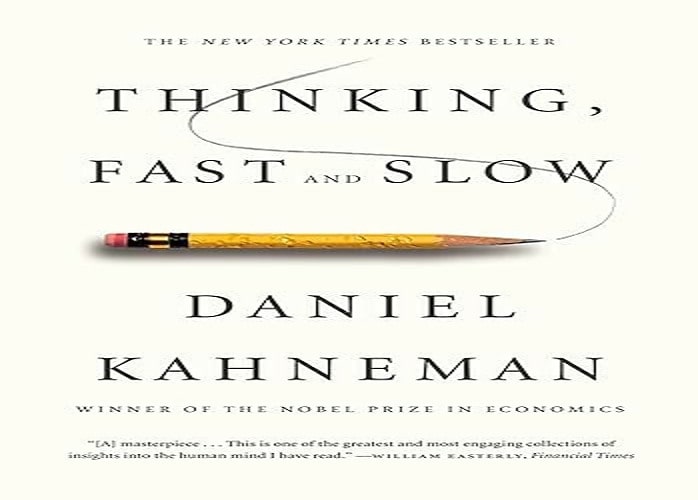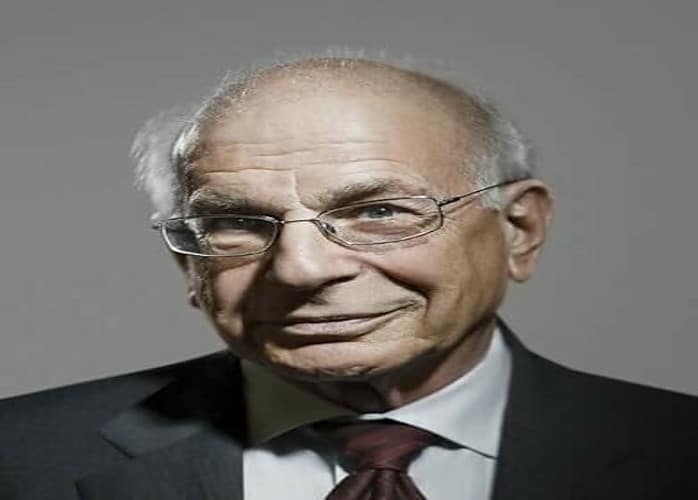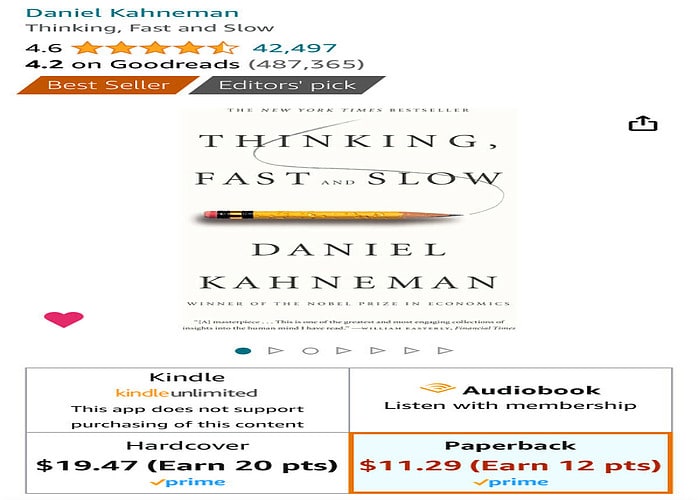Unraveling The Tapestry Of Thought: A Review Of “Thinking, Fast And Slow”

“Thinking, Fast and Slow” by Daniel Kahneman is an intellectual odyssey that takes readers on a captivating journey through the intricate landscape of human cognition. As a Nobel Prize-winning psychologist, Kahneman enriches the exploration of the dual systems governing our thought processes. This modern classic, a bestseller for nearly a decade, has become an essential read, profoundly impacting countless lives.

About the Author:
Daniel Kahneman, the brilliant mind behind this transformative work, is a pioneer in the field of behavioral economics. As a Nobel Prize in Economic Sciences recipient, Kahneman dedicates his career to unraveling human decision-making mysteries. His insights have reshaped our understanding of thought processes and left an indelible mark on psychology and economics.
Best Place to Buy:
For those eager to embark on this intellectual adventure, Amazon emerges as the optimal destination. Moreover, the e-commerce giant not only guarantees easy access to Kahneman’s work but also ensures a seamless shopping experience. Whether you choose to explore his work or make a purchase, the convenience provided enhances the overall experience for users. With a 30-day guarantee, Amazon offers readers confidence as they explore the profound ideas in “Thinking, Fast and Slow.”
My Rating: ⭐⭐⭐⭐⭐ (5/5 stars)

As an Amazon Affiliate, some pages on this website contain sponsored links and advertisements. Affiliate Disclosure.
System 1 is Fast, Intuitive, and Emotional
In this thought-provoking section, Kahneman introduces readers to System 1, the rapid and intuitive thinking system, with skill and insight. Characterized by its quickness, System 1 operates effortlessly, relying on intuition and emotion to swiftly process information. Kahneman guides readers through a captivating exploration of this system, unraveling the intricate interplay between rapid thinking and initial judgments.
Delving deeper into System 1, Kahneman illustrates how this intuitive system finely tunes itself to respond to the world around us. It is the system that enables us to make split-second decisions, often without conscious awareness. Kahneman, through real-world examples and experiments, illuminates System 1’s automatic nature in shaping perceptions and influencing immediate responses.
Furthermore, Kahneman delves into the implications of depending on System 1 for decision-making, emphasizing instances where its swift judgments result in cognitive biases and errors. Your thoughts on these insights, whether shared in the comments section below or through email outreach, are highly valued. The section serves as a rich tapestry of insights into the rapid cognitive processes that underlie our everyday choices, offering readers a profound understanding of how System 1 operates and influences our initial thoughts and reactions.
As we explore, readers gain a nuanced appreciation for the efficiency of System 1 and its adaptive nature in navigating the complexities of our environment. The vivid depiction of the interplay between intuition and emotion provides a solid foundation for understanding the subsequent exploration of System 2 and the intricate balance between these two cognitive systems.
System 2 is Slower, More Deliberative, and More Logical
Seamlessly transitioning from System 1, Kahneman guides readers into the profound depths of System 2—the slower, more deliberate, and logical counterpart. This section unfolds as a thought-provoking journey into the cognitive processes that involve critical analysis and thoughtful decision-making.
Contrastingly, System 2 demands conscious effort and deliberate engagement, standing in stark opposition to its swift counterpart. Additionally, Kahneman illuminates how System 2 operates, offering readers a comprehensive understanding of the mental processes involved in deliberate thinking. Furthermore, through real-world examples, the author vividly portrays the deliberate and logical nature of System 2, emphasizing its role in problem-solving, analytical reasoning, and strategic decision-making.
The contrasting dynamics between System 1 and System 2 come to the forefront, revealing the delicate balance that exists within our minds. Kahneman emphasizes the symbiotic relationship between these two systems, showing how they complement each other in shaping judgments and decisions.
As readers explore System 2, they gain insights into the cognitive effort needed for tasks requiring careful consideration. Additionally, the section acts as a bridge between intuitive and deliberate aspects of human thinking, laying the groundwork for a holistic understanding of decision-making.
The Impact of Overconfidence on Corporate Strategies
Stepping into the corporate realm, Kahneman directs his lens toward the impact of overconfidence on strategic decision-making. Moreover, through compelling analysis of real-world examples and case studies, Kahneman unveils how overconfidence can shape, and sometimes misshape, business strategies.
Readers are taken on a journey through the pitfalls of unwarranted confidence, exploring instances where decision-makers, fueled by overconfidence, make choices that may seem bold but are fraught with risk. Kahneman’s insights provide a nuanced perspective on the delicate balance between confidence and rational decision-making in the corporate arena.
Drawing on extensive research, Kahneman delves into the psychological underpinnings of overconfidence, dissecting its impact on organizational behavior and strategic planning. Additionally, this section serves as a cautionary tale, offering valuable lessons on recognizing and mitigating overconfidence for more informed and resilient corporate strategies.
In unraveling the impact of overconfidence, Kahneman underscores the importance of self-awareness and a realistic appraisal of one’s abilities. Moreover, exploring corporate decision-making becomes a mirror reflecting the broader implications of overconfidence in our lives. This lays the foundation for subsequent discussions on predicting future happiness and cognitive biases.
“In corporate strategies, overconfidence blinds to pitfalls. Success demands discerning the line between confidence and prudent strategy.”
The Difficulties of Predicting Future Happiness
Navigating the unpredictable terrain of human emotions, Kahneman invites readers to reflect on the challenges inherent in forecasting future happiness. This section unfolds as a poignant exploration of the intricacies of human desires and contentment, offering profound insights into the nature of our own expectations and the difficulties we face in anticipating what will truly bring us joy.
Kahneman’s narrative takes on a reflective tone, guiding readers through the complexities of projecting our future emotional states. Drawing on research and personal anecdotes, Kahneman explores biases and errors in predicting long-term happiness. Additionally, he highlights disparities between anticipated and actual emotional experiences.
Through a meticulous examination of the challenges tied to forecasting happiness, Kahneman reinforces the interplay between System 1 and System 2 in shaping our expectations. Furthermore, the inclination to depend on rapid, intuitive judgments, combined with the constraints of deliberate and logical thinking, becomes apparent in our quest for future contentment.
Readers are prompted to question their own assumptions and delve into the psychological factors influencing their projections of happiness. Furthermore, the narrative resonates personally, encouraging introspection and deepening understanding of the nuanced interplay between our present decisions and future emotional well-being.

The Profound Effect of Cognitive Biases on Decision-Making
Broadening the scope of his exploration, Kahneman delves into the pervasive impact of cognitive biases on decision-making. From financial decisions in the stock market to meticulous vacation planning, this section underscores the critical importance of comprehending biases for making informed choices and steering clear of common pitfalls.
Kahneman unravels a tapestry of cognitive biases, demonstrating their influence on various aspects of our lives. Through vivid examples and practical illustrations, readers acquire a comprehensive understanding of how these biases manifest in different scenarios. Moreover, this section serves as an eye-opening journey into the subtle ways our minds deviate from rationality, resulting in decisions that may not align with our best interests.
As readers navigate through the exploration of cognitive biases, Kahneman provides a toolkit for recognizing and mitigating their effects. Drawing on research and real-world anecdotes, Kahneman empowers readers with the knowledge to navigate decision-making with greater awareness and resilience against common cognitive pitfalls.
The narrative in ” Thinking, Fast and Slow” develops as cautionary tales, emphasizing the importance of critical thinking and self-awareness in addressing cognitive biases. Additionally, Kahneman adeptly connects academic research with practical insights, ensuring readers comprehend theoretical concepts and appreciate their relevance in everyday decision-making.
Engaging the Reader
Throughout the entirety of “Thinking, Fast and Slow,” Kahneman maintains a captivating dialogue with the reader about the intricacies of human thought. The engagement extends beyond providing information; it’s interactive, prompting readers to contemplate their cognitive processes and decision-making tendencies.
Kahneman’s writing style is both accessible and profound, facilitating a seamless connection for readers with the content. Additionally, through relatable anecdotes, thought experiments, and scenarios, he ensures that psychological concepts are presented in a manner that resonates with a diverse audience.
The lively conversation sparked by Kahneman extends beyond the theoretical framework, urging readers to apply insights to their own lives. Furthermore, the author’s dedication

Conclusion
“Thinking, Fast and Slow” stands as an indispensable guide to understanding the tapestry of human thought. Daniel Kahneman’s exceptional skill in unraveling the intricacies of cognition renders this book a timeless masterpiece. Its enduring presence on bestseller lists is a testament to its lasting relevance and impact. For individuals in search of profound insights into decision-making and the human psyche, this contemporary classic ensures a transformative experience.
Take a journey through the themes addressed ” Thinking, Fast and Slow” studying the subtleties of decision-making. Take a moment to look deeply into your thoughts, and if you choose to share your findings, your contribution will be eagerly received and greatly treasured. Whether you want to share your ideas in the comments section below or via email, I am eager to hear from you and learn about your insights on this transformational mental journey.
Related: Unleashing Potential: “The Magic Of Thinking Big” Book Review
The Power Of Positive Thinking Book- Simple Results
Book Review: “Intuition: Knowing Beyond Logic
Unlocking Joy: Tips To Become Happier And More Empowered
Book Review: “How Successful People Think” By John C. Maxwell

Kiersti writes on self-love and personal development professionally. Over the past ten or so years, she has studied self-love and personal growth. Visit https://womansdailyneeds.com/ to learn more about what she does, and like her on Facebook at https://facebook.com/womansdailyneeds to keep up with her.

12 Responses
“Thinking, Fast and Slow” by Daniel Kahneman is a compelling exploration of the two systems that drive the way we think: the fast, intuitive System 1 and the slower, more deliberate System 2. Through engaging anecdotes and rigorous research, Kahneman delves into the biases and heuristics that influence our decision-making processes. This insightful book not only sheds light on the quirks of human cognition but also offers practical strategies for making better choices in both personal and professional spheres. It’s a must-read for anyone interested in understanding the complexities of the human mind and improving their decision-making abilities. The Nobel Prize winning author asks you to look deep into your though system and consider what influences our decision making processes. Super insightful and very intelligent and deep.
“Thinking, Fast and Slow” by Daniel Kahneman is indeed a fascinating exploration of how our minds work. Kahneman’s distinction between System 1 and System 2 thinking is particularly enlightening, showing us how our decisions are often shaped by intuitive, automatic processes rather than deliberate, analytical reasoning. The book’s insights into biases and heuristics offer valuable lessons for improving our decision-making in various aspects of life. Kahneman’s Nobel Prize-winning work challenges us to reflect on our thought processes and consider the influences that shape our choices. It’s a profound and thought-provoking read that can enhance our understanding of human cognition.
I appreciate the review’s thoroughness, clarity, engaging style, and personal reflections, as well as its invitation for interaction. It provides a comprehensive overview while also fostering a sense of community among readers.
How does Daniel Kahneman’s exploration of cognitive biases in “Thinking, Fast and Slow” prompt readers to reevaluate their decision-making processes and strive for greater self-awareness in everyday life?
Daniel Kahneman’s exploration of cognitive biases in “Thinking, Fast and Slow” prompts readers to reevaluate their decision-making processes by revealing the various shortcuts and errors that our minds often make. By understanding these biases, readers can become more aware of their own thinking patterns and recognize when they might be making decisions based on flawed reasoning.
Kahneman’s work encourages readers to strive for greater self-awareness by highlighting the importance of engaging with both System 1 and System 2 thinking. System 1 thinking is quick and intuitive but prone to biases, while System 2 thinking is more deliberate and analytical but requires effort.
By learning to recognize when each system is at play, readers can improve their decision-making by consciously engaging the appropriate system for the situation.Overall, “Thinking, Fast and Slow” serves as a powerful reminder of the complexities of human cognition and the importance of being mindful of our thought processes. It encourages readers to be more aware of the factors influencing their decisions and to strive for greater self-awareness in their everyday lives.
Hey Kiersti,
I stumbled upon your review of “Thinking, Fast and Slow,” and it instantly brought back memories of when I read this insightful book a while ago. Your analysis perfectly captures the essence of Daniel Kahneman’s groundbreaking work. I couldn’t agree more with your assessment of the dual systems of thinking and the impact they have on our decision-making. Did you find any specific strategies from the book that have proven useful in your own life? Thank you for taking the time to unravel the tapestry of thought woven within this remarkable book. It’s a must-read for anyone seeking a deeper understanding of the human mind!
Marios
Hey there,
I’m glad my review resonated with you! “Thinking, Fast and Slow” is indeed a thought-provoking book. One strategy I found particularly useful is Kahneman’s concept of “thinking slow” for important decisions, allowing for deliberate and rational thought processes rather than relying solely on intuition. This approach has helped me approach complex decisions more carefully and avoid common cognitive biases.
Hi Kiersti,
“Thinking, Fast and Slow” offers a deep dive into decision-making, reshaping our understanding of cognition. Kahneman seamlessly blends behavioural economics, shedding light on how biases influence our lives.
I admire Kahneman’s ability to simplify complex ideas, making them accessible to all. However, some critique the book’s binary view of thinking and question the reliability of certain studies.
Yet, amidst its influence, “Thinking, Fast and Slow” faces scrutiny. Some argue its binary perspective oversimplifies cognition, potentially neglecting its complexity. Furthermore, debates persist about the reproducibility of certain studies, casting doubt on their reliability. Despite this, “Thinking, Fast and Slow” remains an invaluable resource for those interested in cognitive psychology, prompting introspection about our decision-making processes.
Thanks for your comment I appreciate it.
Hi there
Thanks for your informative article.
If I can just comment on Kahneman’s exploration of System 1, it offers a captivating journey into the realm of rapid and intuitive thinking. With meticulous detail and compelling real-world examples, I like how he unveils the automatic nature of this system, shedding light on its pivotal role in shaping our perceptions and immediate responses.
I found it was interesting how his insightful analysis delves into the consequences of relying solely on decision-making, as there are inherent biases and errors that can arise.
But all in all through this rich tapestry of insights, readers are not only granted a profound understanding of System 1’s operation but also encouraged to reflect on the intricate interplay between intuition, emotion, and cognitive processes in our everyday choices.
Well done.
Thanks so much for your comment I appreciate it.
This book’s premise is both compelling and thought-provoking, as it challenges readers to reconsider their assumptions about how they perceive and process information. By shedding light on the hidden biases and mental shortcuts that influence our everyday choices, Kahneman invites us to introspect and reflect on the factors that drive our decision-making processes.
Moreover, the premise of “Thinking, Fast and Slow” underscores the importance of critical thinking and mindfulness in navigating the complexities of the modern world. By gaining insight into the mechanisms of our minds, readers are empowered to make more informed decisions and cultivate greater self-awareness.
Overall, the premise of the book is not only intellectually stimulating but also deeply relevant to our lives, offering valuable insights into human cognition and behavior that have far-reaching implications for personal growth, professional success, and societal well-being. Thank you for this review.
Thanks so much for your comment I highly appreciate it.